Not like Amazon: Why China’s Alibaba has stalled after a meteoric rise

- Alibaba was conceived as a website that could capitalize on and improve upon China’s nascent e-commerce market.
- Foreign investors were eager to buy stock in Alibaba because the company allowed them to place their finances in a lucrative but otherwise inaccessible environment.
- Due to government crackdowns and market ceilings, the tech giant has been in decline for some time now.
The company that would eventually blossom into Alibaba Group Holding Limited was founded on June 28, 1999, by Chinese entrepreneur Jack Ma in Hangzhou, the capital city of China’s Zhejiang province. The plan was to launch an online marketplace that could capitalize on and improve upon China’s nascent e-commerce market by connecting manufacturers, sellers, and consumers on a single platform.
“Alibaba’s special innovation,” co-founder Ming Zeng wrote in the Harvard Business Review, “was that we were truly building an ecosystem: a community of organisms (businesses and consumers of many types) interacting with one another and the environment (the online platform and the larger off-line physical elements). Our strategic imperative was to make sure that the platform provided all the resources (…) that an online business would need to succeed.”
Each of these resources represents a different arm of Alibaba’s corporate structure. Alongside consumer-to-consumer services, the company also offers business-to-consumer and business-to-business services. Logistics services and supply chain management solutions are available for businesses through Cainiao, while Alibaba Cloud develops global cloud computing software that covers storage, security, network virtualization, big data analytics, and mobile workspace platforms.
Those are just the core pillars. Emulating its American rivals, Alibaba has also branched out into entertainment, with Alibaba Pictures taking care of content production, distribution, and licensing while also selling data services to other entertainment companies. Another segment, Tmall Genie, deals in home appliances such as smart speakers and remote controls. Like Amazon or eBay, Alibaba is also involved in digital marketing, using data collected on its various platforms to drive targeted ads.
Inseparable from Alibaba’s origin story — and commercial success — is its brand identity. During an appearance on CNN’s TalkAsia, Ma said the name came to him while he was at a coffee shop in San Francisco. He immediately tested its recognizability on the waitress, who not only recalled the corresponding myth from A Thousand and One Nights, but also the phrase “Open Sesame.” Just as Alibaba the character slipped into the heavily guarded den of thieves, so too would Alibaba the company enter China’s e-commerce market.
The largest IPO in history
Alibaba has come a long way. Just three months after the company was founded, Ma and his team received a $25 million investment from SoftBank and Goldman Sachs. This investment paid off quickly, as Alibaba.com reported its first profit in 2002 (Amazon, by contrast, took around five years to become profitable). In 2021, Alibaba’s total revenue reached $109.48 billion — a 52% increase from the year before. The company’s net income for 2021 was $22.94 billion, an 8.8% increase from 2021.
The reasons for Alibaba’s success are as elusive as they are manifold. A 2009 study from Chongqing Technology & Business University lists a “strong brand, providing customers with outstanding value and a superior shopping experience, massive sales volume and realizing economies of scale” as possible explanations. More may be gleaned from reports of Alibaba’s 2014 initial public offering which, bringing in a total of $25 billion, became the biggest IPO in history.
First and foremost, Wall Street investors were excited by the company’s high profit margin. At the time, Alibaba’s net income was $2 billion per year. To put that into perspective, eBay’s yearly profit amounted to little over $676 million, while Amazon had reported a loss of $126 million. Alibaba maximizes profits by minimizing expenses. Unlike Amazon, the company does not operate fulfillment centers. As a result, it is able to save money on manpower as well as operating costs.
According to Time magazine, investors were “also excited because Alibaba offers the most direct way to own a piece of China’s booming tech scene.” That scene is not only huge (the country has an internet population of 1.02 billion and counting), but also notoriously inaccessible to the West. Other Chinese tech giants like Tencent trade only on Hong Kong’s stock exchange, and when eBay attempted to expand eastward in 2003, it was outcompeted and eventually pushed out by Alibaba.
Reasons for Alibaba’s success — and stagnation
The success of Alibaba has rested in part on the company’s uncanny ability to anticipate the development of e-commerce in China. At first, Ma and his team catered to established businesses like marketing, logistics, and finance. But as time went on, Alibaba also appealed to emerging ones, including affiliate marketing and social media influencers. “As we expanded our ecosystem,” recalls Zeng, “we helped create new types of online businesses, completely reinventing China’s retail sector along the way.”
The unbelievable scale of Alibaba’s business model is also worth noting. Just as China’s WeChat offers text messaging, video calling, money transferring, and social media rolled into one app, so too does Alibaba move beyond its original purpose as a platform that simply connects buyers and sellers. Alibaba.com is part marketplace, part delivery service, part search engine, and part online payment system. By keeping all these amenities under a single roof, Alibaba can easily facilitate synergy.
This is not to say that Alibaba is without problems. As recently as 2018, the company was ranked among the top 10 global companies in terms of market cap. Nowadays, however, it rests at number 33. As a retailer, Alibaba is bringing in less money than businesses like Home Depot, Metro AG, and Ahold. Earnings reports show the company has been in decline since 2021. This year, profits fell by 57.4%. Revenue continues to increase, but that growth is slowing by the quarter.
Interestingly enough, Alibaba peaked shortly before the Chinese Communist Party started to crack down on big tech companies. In 2021, Beijing strengthened the enforcement of antitrust laws after finding that several companies, from Alibaba and Tencent to the search engine Baidu and the video-sharing platform ByteDance, were abusing their market power. The underlying idea was that the private sector should sacrifice part of its wealth for the sake of socioeconomic equality. A recent op-ed in Bloomberg considers another possibility, arguing that Alibaba is hurting because China’s e-commerce market has reached a ceiling. Alibaba CEO Daniel Zhang seemed to confirm as much when he told investors the company has “substantially captured all consumers with purchasing power in China” and must now shift its focus from new-user acquisition to user retention” if it is to keep growing. Alternatively, Alibaba could try its luck overseas. But can it succeed where retailers like eBay failed?





